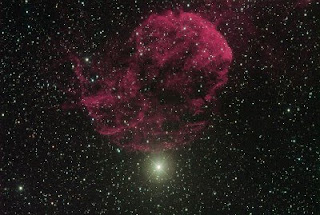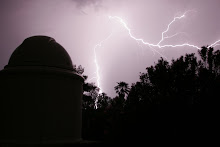Last night was the first star party at the
Tucson Amateur Astronomy Association's new Chiricahua Astronomy Complex.
We've been eagerly waiting for this night for several years, beginning with a test visit that several of us made on a warm summer's night a few years ago. It's been a long haul - Cochise County has placed many restrictions on the club during the acquisition and development of the property. I won't go into details here (there are enough to fill a small book!), but the County just granted approval for us to actually allow events to occur on the site this past week.
So far we only have basic facilities - parking lot, electricity, bathroom, etc. - but we have the beginnings of a fantastic club observing site. Long range plans include full observatories and pads to set up telescopes.
I was too tired to take all of my imaging gear out, so instead I just brought a visual instrument, my 15" Dobsonian. My buddy Larry drove down with me in my "AZTRNMY" pickup, and we hauled his 18" Dob along as well. The photo above shows our scopes getting ready for work, and there were many other scopes set up all around us. There were 24 people there (I think), and the excitement level was high.
The sky was very clear, and my Sky Quality Meter gave nice dark readings of 21.68 magnitudes per square arcsecond by early evening. The Zodiacal Light was prominent for a while after sunset - this is a faint glow along the ecliptic that results from sunlight reflecting off of dust in space, and is generally only visible from very dark sites. Later in the evening I measured 21.81 on the meter, which is about as dark as I've ever been able to get anywhere. There are some lights along the distant horizon but they really didn't affect the observing.
My friend and imaging mentor Dean brought his ccd equipment and started off his session with a quick one of Messier 34, an open cluster in Perseus.
Click here to see his image, which was taken in honor of The Perseus Group, the 4 members who donated the parcel of land to the club.
I spent my time visually observing and socializing with friends. One of the great things about a star party is sharing the night sky and outdoors with wonderful people, and last night was no exception. I viewed numerous objects through a variety of scopes and eyepieces. Mars was a favorite target, with the polar ice cap as well as dark surface markings clearly visible. The Orion Nebula, M42, was another object whose photons graced the surfaces of many mirrors last night. One of the more unusual visual objects that I observed last night was the Horsehead Nebula. Although that is a popular imaging target (in fact I have many hours of unprocessed ccd data on it), it's rare in the eyepiece. I used my H-Beta filter on the 15" and several of us enjoyed the view. There were a lot of other nebulae, galaxies, star clusters, etc. that we viewed, along with plenty of laughter and swapping of stories.
Seeing was very good, with a steady sky making it easy to pick out details in the objects we observed. All in all it was a great night and I can't wait for more to come!
 Xanadu Observatory is now capable of 24-hour astronomy, with the addition of a Lunt LS100THa Solar Telescope. This scope allows direct observation of the nearest star. It's a refractor with a special tuning and filtering system to allow transmission of only a very slight amount of the sun's light. Normally, one would go blind from looking at the sun, but this scope makes it safe.
Xanadu Observatory is now capable of 24-hour astronomy, with the addition of a Lunt LS100THa Solar Telescope. This scope allows direct observation of the nearest star. It's a refractor with a special tuning and filtering system to allow transmission of only a very slight amount of the sun's light. Normally, one would go blind from looking at the sun, but this scope makes it safe.
















































